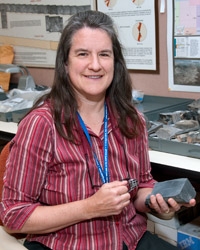Characterization of Hydraulic Fractures in Slant Core from the Hydraulic Fracture Test Site Project in the Wolfcamp Formation, Midland Basin, West Texas
Presenter
Dr. Julia Gale
Senior Research Scientist
Bureau of Economic Geology
Abstract
A slant core taken through the stimulated reservoir at the Hydraulic Fracture Test Site (HFTS1) in the Wolfcamp Formation, Midland Basin, West Texas, provided direct information about the distribution and attributes of hydraulic fractures in two adjacent stimulated wells. In ~600 ft (182.9 m) of core, 375 E–W striking hydraulic fractures were captured, in addition to 309 calcite-filled natural fractures, and numerous drilling-induced and core-handling fractures.
Previously published work from this project focused on criteria for distinguishing different fracture types, and identification of proppant from the stimulated wells. Here, we focus on characterizing the hydraulic fractures attributes. Many of the hydraulic fractures are remarkably smooth and planar, especially in the mudrocks; in coarse carbonate debrites they tend to be rougher and are somewhat irregular. Where hydraulic fractures encounter concretions individual fracture planes commonly become complex fracture networks. Some hydraulic fractures have surface markings such as steps, twist hackles and plumose structure, from which hydraulic fracture propagation directions may be determined. Hydraulic fractures are not evenly distributed along the core length, but commonly occur close together in pairs or clusters, where fractures are not quite parallel. We interpret this as an indication of bifurcation, which can also be used to infer propagation direction. Propagation direction varies, in some cases even for fractures in close proximity to each other.
Reactivation of natural fractures has occurred but cannot be ascribed to hydraulic fracturing with certainty. Natural fractures oriented close to SHmax (Set 2) are twice as likely to reactivate than those oriented at a higher angle to SHmax (Set 1). There was very little reactivation of bedding planes. The greatest concentration of hydraulic fractures occurs where the slant core comes closest (~85 ft) to one of the stimulated wells. Although perforation clusters from the stimulated well can be viewed alongside the observed hydraulic fractures, direct links have not been established. Different scenarios for growth from the perforation clusters could be responsible for the hydraulic fractures observed.
